1 Volumes
Rt. Angle by Years
The history of Philadelphia"s finest men's club.
Right Angle Club 2007
A report, to the year 2007 shareholders of the Right Angle Club of Philadelphia, by the outgoing president.
REFERENCES
| The Right Angle Annual Reports 2007 George Ross Fisher MD | Ross and Perry Inc. |
It's timely for the outgoing president to extend sincere thanks to those who made our club function this year. Since the passage of the year has been happy for all of us, not least for me and at least until high spirits were enhanced by distilled spirits this evening, it also seems appropriate to reflect on the unique way this club functions. Please consider this a report to the shareholders.
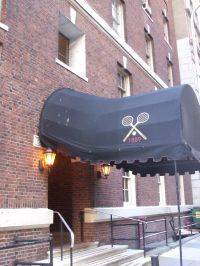
|
| Racquet Club |

|
| Rosie |

|
| Jack Hinckle |
Our bartender Gerry Hernandez has an even briefer time to accommodate the spiritual needs of the club from noon to 12:33 PM, and like our coatroom attendant Elizabeth, never skips a beat or asks a name. Unseen to most of you is the club secretary Le Anne, who sends out those notices and witticisms composed by Jack Hinkle. We have a very good arrangement with the Racquet Club; we help them out a little with their overhead, perhaps, but in return we should get down on our knees for the wisdom of our ancestors -- NOT to own our own clubhouse.
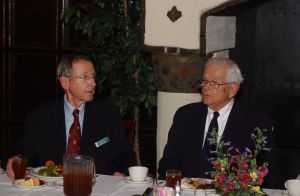
|
| Neale Bringhurst |
And while down on our knees, give thanks for not having our own paid administrative staff. Instead, we share administrative tasks among eleven volunteer members, choreographed like a minuet. First of all is our program chairman,  Jack Nixon, who assembled a perfectly spectacular array of forty luncheon speakers, and got them to the church on time. Meanwhile, unknown to him, he was quietly growing a cancer, of which he rid himself a few weeks ago, but not without experiencing some hair-raising episodes in the process. Our special events chairman,
Jack Nixon, who assembled a perfectly spectacular array of forty luncheon speakers, and got them to the church on time. Meanwhile, unknown to him, he was quietly growing a cancer, of which he rid himself a few weeks ago, but not without experiencing some hair-raising episodes in the process. Our special events chairman,  Buck Scott, lined up elegant dinners in the more exclusive watering holes of Philadelphia, for us and our special companions, never missing a beat or leaving an empty chair. There was the Merion Cricket Club, the Philadelphia Cricket Club in Chestnut Hill, and David Leith's mansion opposite the Merion Golf Club, designed by Horace Trumbauer. My successor Neale Bringhurst shared in the same sort of chores for the dinner this evening, while my predecessor Tom Howes quietly supplied ribald stories for those of us who suffer a handicapped condition in that regard, meanwhile offering whispered advice about the pace and processes of a stumbling new president.
Buck Scott, lined up elegant dinners in the more exclusive watering holes of Philadelphia, for us and our special companions, never missing a beat or leaving an empty chair. There was the Merion Cricket Club, the Philadelphia Cricket Club in Chestnut Hill, and David Leith's mansion opposite the Merion Golf Club, designed by Horace Trumbauer. My successor Neale Bringhurst shared in the same sort of chores for the dinner this evening, while my predecessor Tom Howes quietly supplied ribald stories for those of us who suffer a handicapped condition in that regard, meanwhile offering whispered advice about the pace and processes of a stumbling new president.
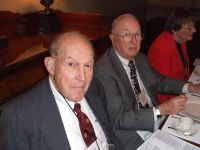
|
| Hinckle and Bates |
The Hinkles, father and son,kept us supplied with 1. name tags, 2. ties, 3. rosettes, and 4. engraved pewter plates, almost like magic. Time and again I looked under the counter in the grill room expecting to find no plate, or a plate engraved with the wrong name; it never happened, even once. The slide projector always worked, the ship's bell always rang when I banged it, there were always mints at the door as we left.  Some of us kept dropping our nametags on the floor as we milled about; Rosie always found them. Our recording secretary Alan Lawley kept formal notes of that shouting match called a Board of Control, and without instruction, exercised utmost discretion in describing events.
Some of us kept dropping our nametags on the floor as we milled about; Rosie always found them. Our recording secretary Alan Lawley kept formal notes of that shouting match called a Board of Control, and without instruction, exercised utmost discretion in describing events.
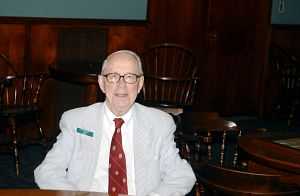
|
| Jack Baird |
Although Jack Baird regularly detected flaws in grammar and punctuation in the minutes, even learned counsel like Dick Palmer was never able to detect a suitable legal quibble about the content. Joe Martinez struggled with the roster and mailing list, assembling the new members and mourning the resignees with unsparing dedication. And what other club can boast of having two sturdy troopers of the City Cavalry running its lotteries?
Joe Martinez struggled with the roster and mailing list, assembling the new members and mourning the resignees with unsparing dedication. And what other club can boast of having two sturdy troopers of the City Cavalry running its lotteries?
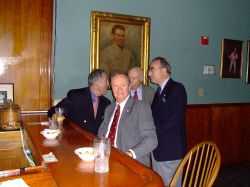
|
| Joe Martinez |
Dan Sossaman and John White relieved us of the need to pay city cops for protection of our gambling operation, a notable saving for our treasury. Speaking of which, Rod Rothermel actually seems to enjoy sending out bills and scolding delinquents, and furthermore organizing affairs so that auditing our books would be an absurdity. Although this year showed some variation, we typically run this operation on forty-five thousand of what passes in 2007 for dollars. The Racquet Club bill usually runs twenty thousand a year, the special events are an equal amount, and the other five thousand is for name tags, ties, rosettes and plates. Multiply the annual dues by sixty five members and you can cross-foot the accuracy of that accounting in your head, when you are sober. We donated $600 of lottery profits to PAL, The Police Athletic League.
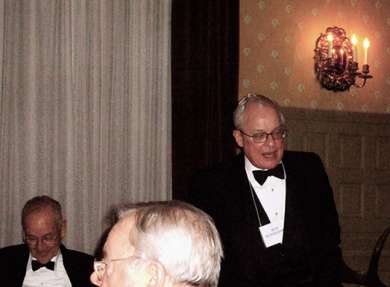
|
| Rod Rothermel |
There is one other volunteer of essential importance; the nominating chairman Bill Dorsey. It is his quiet and unseen work that identifies ten volunteers who will accept these tasks and faithfully carry them out. That's just for this year, of course, eventually everybody gets a chance to help out, both in the past and in the future.

|
| Dan Sossaman |
That's the spirit of American volunteerism so notably promoted by Ben Franklin. Many other clubs hire professional administrators to do this work for them while the members luxuriate in what they imagine are busy lives. We could do that, too; all it takes is two or three big shots on the Board of Control to set it in motion. It would cost us at least a hundred thousand dollars a year, and might be double that if it went unsupervised. It would thus result in each one of our members being assessed annual dues of about fifteen hundred extra dollars.
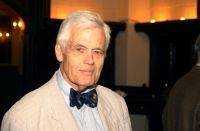
|
| William G. Dorsey |
We might be able to afford it, but we wouldn't. One by one the members would drop out, and new members would be strangely hard to find. The first economy would soon be to drop the special events, the second would be the elimination of the trinkets. In a dozen ways, quality would deteriorate, and it all wouldn't seem worth it anymore. Like the old Rittenhouse club, we would soon be an empty shell. The young French tourist Alexis de Tocqueville marveled in 1840 at the many volunteer organizations he found in America. Tocqueville struggled all his life with the contrasting success of the American Revolution, and the mess created by the French Revolution, a difference which he attributed to the spirit of the frontier and the lingering traces of European aristocracy in his own country. It was no such thing. Volunteerism is the way to go because it is cheaper, and because it is cheaper, we do things we would not otherwise trouble to do.
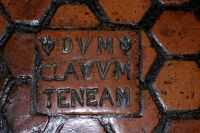
|
| CLAVVM |
Although economy is the plain fact of the matter, in a curious way it is not the only fact. There exists one example of a club, in this case of eighty members, to which money really is no object. Oxford University has a constituent college without any students, called All Souls College. It was created by King Henry VI to provide a set of ordained priests to pray for the souls of those who died in the battle of Agincourt. You may have heard of ivory towers, a term which was in fact first invented to describe the twin white towers of All Souls, although with time they are scarcely very white anymore. Without taxes and following a rule to spend only one percent of endowment yearly, the original endowment in the Thirteenth Century has now grown to about four hundred million dollars by the operation of compound interest. The priests and the prayers have long since been dispensed with, replaced by the new system of nomination of at most two Oxford graduates yearly, selected by a competition in which only the summa cum laudies of each of the thirty-nine Oxford colleges are allowed to compete. In some years, only one or even no one is deemed worthy of selection.In all those centuries, no one ever resigned from All Souls. Lawrence of Arabia was a fellow, and three Viceroys of India, plus prime ministers and such. It must be fun to be a member, because most of the fellows actually travel back to Oxford every weekend of their lives, just to join the revelry in the great hall. As they say, they have found a way to eat and drink their way to national power. These men have families, friends and businesses to run; no matter, they go back to Oxford for the weekend, wouldn't miss it. There's no volunteerism at All Souls, plenty of flunkies to fill the overflowing cups. With four hundred million dollars at one percent and only eighty member fellows, you can do the math yourself. That club, at least, is very likely to last forever no matter what it does, whereas our own must earn its way, every year.
The priests and the prayers have long since been dispensed with, replaced by the new system of nomination of at most two Oxford graduates yearly, selected by a competition in which only the summa cum laudies of each of the thirty-nine Oxford colleges are allowed to compete. In some years, only one or even no one is deemed worthy of selection.In all those centuries, no one ever resigned from All Souls. Lawrence of Arabia was a fellow, and three Viceroys of India, plus prime ministers and such. It must be fun to be a member, because most of the fellows actually travel back to Oxford every weekend of their lives, just to join the revelry in the great hall. As they say, they have found a way to eat and drink their way to national power. These men have families, friends and businesses to run; no matter, they go back to Oxford for the weekend, wouldn't miss it. There's no volunteerism at All Souls, plenty of flunkies to fill the overflowing cups. With four hundred million dollars at one percent and only eighty member fellows, you can do the math yourself. That club, at least, is very likely to last forever no matter what it does, whereas our own must earn its way, every year.
Our own club is only eighty years old, still has no endowment or hired administration. We will last only so long as the members want us to last, and as long as everyone takes a turn with the chores. If we coast along for even one year, certainly if we coast for five years, we will become a faded memory. It is thus with the greatest pride that I look out at the lunch tables on Friday and see nearly every chair filled. We are here because we want to be here, every man Jack of us. No one knows better than I that we have defects. But surely we are doing something right.
What follows next is a set of reviews of most of the Friday luncheon topics of the year 2007. If someone asks what it is we talk about, these little essays try to display the current answer.
Whither, WHYY

|
| WHYY Logo |
Although presently scheduled to happen between the November 2008 elections and the actual onset of the newly elected government, a big event has been postponed twice, and may be postponed again. The event in question is federal prohibition by Congress of further American broadcasting of analog television, the only free television now being broadcast. Congress has passed such a law, and the President has signed it. Even if you aren't a cynic, it's hard to believe the cable television industry isn't overjoyed, if not a little culpable. Presumably, useless analog television sets will then be put out at the curb for trash collection simultaneously. One could, however, imagine that trash collectors will be busy attending protest riots in Washington, so you can't be entirely sure the trash will be picked up. The Constitution provides for lame-duck sessions of Congress just before this impending moment, so perhaps all can be rescued by chastened legislators.
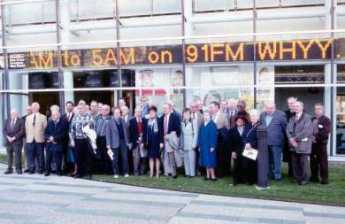
|
| WHYY Offices |
That's one vision of the future. An alternative would be that the spin industry will work us up into a buying frenzy for high-definition television (HDTV) by that time, so the nation may eagerly line up in front of discount stores to buy a technological marvel that renders current television a laughable joke we can hardly wait to eliminate. Judge for yourself, because HDTV capable television sets are already on display in the shops, side by side with the old-fashioned variety. Unfortunately, it is a little hard to observe much difference. The present spin is that HDTV, or digital television, will be such a dramatic improvement that any transitional disruption will be ignored.
In fact, improved reception isn't the issue at all, more bandwidth is. Analog transmission is a bandwidth hog, severely limiting the number of channels available for licensing. Digital transmission would permit a vast increase in the number of channels available to use the free airways, making heftier competition for cable transmission, also a notorious political plum, as all utilities somewhat are. Dig a little deeper and you find that not only is the issue fifty dollars a month versus free, or ten channels versus two hundred, it also has to do with the vast overbuilding of fiberoptic networks by that bearded CEO fellow who went to jail, and the subsequent scooping up of fiberoptic by the Chinese, Google, or whoever. But set that aside. The current buzz is that WHYY, or Channel 12 the Public Broadcasting System, will expand to channels 12.1, 12.2, 12.3 and 12.4. That will give Philadelphia a full-time arts and culture channel, in addition to the present channel 12, which is now somewhat overweighted with environmental photography. It's hard to know whether the existing arts and culture institutions, which charge admission to their content, will welcome or deplore a new competitive medium in their midst. Some of the grimmer realities of the matter are highlighted by the additional reality that Channel 12 will be given yet another two channels to fill, and presently isn't at all sure where any content will come from. One of the most discouraging features of the present single PBS channel is the obvious shortage of money for programming purposes, sadly evident in the irritating and humiliating marathons of public pleading and begging for contributions. If there isn't enough revenue to support one channel, how can four be financed?
WWW.Philadelphia-Reflections.com/blog/1175.htm
Recording for the Blind and Dyslexic
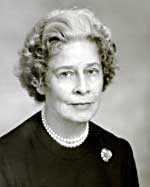
|
| Anne Mc Donald |
Anne T. Macdonald developed the idea in 1948 that a large number of blinded war veterans would benefit from recorded textbooks. Starting at the New York Public Library and now with a national headquarters in Princeton, a string of 29 centers have appeared across the nation, with an average of 7000 volunteers contributing their time reading textbooks into recording devices. The Philadelphia effort started at 36th and Market and has since moved to King of Prussia, where 280 volunteers read in teams of two, one inside the recording booth, and the other outside following the performance and stopping it for errors or muffled recordings. Since the effort specializes in technical textbooks, there is a constant search for specialists in particular technical fields. It is particularly important to understand the technical nature of the material when pronunciation is difficult, and when complicated graphs or illustrations need to be described for a blind audience. Originally, the material was produced on reels of tape but tends nowadays to concentrate on CDs and other disc recording devices.
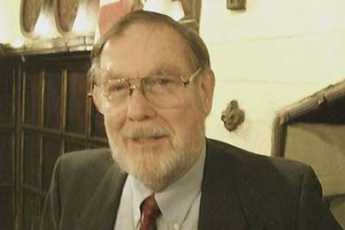
|
| Ralph Cohen |
Ralph Cohen, himself a volunteer reader, very kindly described the enterprise to an audience at the Right Angle Club of Philadelphia recently. It is particularly heartening to hear stories of blind persons receiving advanced technical degrees because of the availability of these recorded texts, even stories of those who rose from menial jobs to become engineers through this pathway.
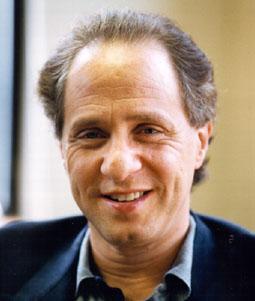
|
| Ray Kurzweil |
For those who have a particular interest in the topic, a few facts are important to know. Volunteers in technical fields are particularly needed, with two-hour recording slots extending over a relatively long time until a text is completed. Contributed money is needed in order to buy equipment and house it in a soundproof environment. Because of concern about copyright infringement, it is necessary to insist that the recorded products are only available to members of the reader's group, each one certified to be in need of such material because of a physical handicap. There is a fee of $65 to enroll, with $35 annual dues.
An interesting sidelight on reading difficulties emerges from the fact that most people who need help can see perfectly well. The disorder of dyslexia is so widespread that probably a majority of the population has at least a trace of it. The underlying problem with dyslexia lies in the brain, not in the eyes. The most common variant is to invert the sequence of words or letters, making such people utterly unable to record or remember a telephone number in the correct sequence. Often, psychological difficulties follow, as impatient siblings and acquaintances describe the victims as "stupid", a slur they often come to believe, themselves. A learning difficulty leads to a lack of learning, and the deficit becomes a real one. To the degree that these Recordings for the Blind and Dyslexic allow some to conquer their handicaps gives hope to others. One can even hope to see the whole matter unwind into a revision of the educational process, leading to a better and more prosperous society.
By an interesting coincidence, 1948 was the year Ray Kurzweil was born in Brooklyn. Developing an early interest in computers, his name is now associated with synthetic speech and voice recognition technology, and he has even branched out into music synthesis. He's a visionary, all right, and a promoter. If voice transcription gets tweaked just a little more, it is going to replace dictaphones and secretaries by the hundreds of thousands. No doubt Kurzweil is destined to become very rich if indeed he is not already so. It's thus a little startling to encounter him as a professional entertainer on the lecture circuit, apparently driven relentlessly by a need to be appreciated. If that's what he needs, let's give it to him. The transformation of half of our society seems within his grasp. And in many ways his success is based on the flash of insight that dyslexic people are not stupid; in fact, maybe no one is. We all walk around with computers in our skull, and computers are always full of bugs. No doubt it should be said of brains, as it is of computer programs, that one has never been created that did not contain many "bugs". The important issue is not whether the computer is defective, but whether it somehow mobilizes the effort to overcome its defects.
WWW.Philadelphia-Reflections.com/blog/1182.htm
Native Habitat
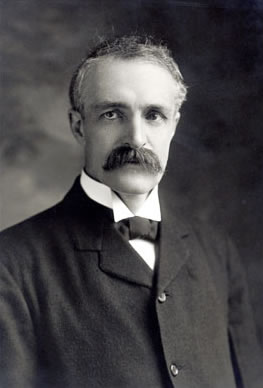
|
| Gifford Pinchot |
Teddy Roosevelt's friend Gifford Pinchot is credited with starting the nature preservation movement. He became a member of the Governor's cabinet in Pennsylvania, so Pennsylvania has long been a leader in the formation of volunteer organizations to help the cause. Sometimes the best approach is to protect the environment, letting natural forces encourage the growth of butterflies and bears in a situation favorable to them. Sometimes the approach preferred has been to pass laws protecting threatened species, like the eagle or the snail darter. Sometimes education is the tool; the more people hear of these things, the more they will be enticed to assist local efforts. The direction that Derek Stedman of Chadds Ford has taken is to help organize the Habitat Resource Network of Southeast Pennsylvania.

|
| butterfly |
The thought process here is indirect and gentle, but sophisticated; one might call it typically Quaker. Volunteers are urged to create a little natural habitat in their own backyards, planting and protecting plant life of the sort found in America before the European migration. If you wait, some insects which particularly favor the antique plants in your garden will make a re-appearance, and in time higher orders like birds that particularly favor those insects, will appear. The process of watching this evolution in your own backyard can be very gratifying. To stimulate such habitats, a process of conferring Natural Habitat certification has been created. In our region, there are over three thousand certified habitats.
Of course, you have to know what you are doing. Provoking people to learn more about natural processes is the whole idea. For example, milkweed. That lowly weed is the source of the only food Monarch butterflies will eat, so if you want butterflies, you want milkweed. For some reason, perhaps this one, the Monarch is repugnant to birds, so Monarchs tend to flourish once you get them started. After which, of course, they have their strange annual migration to a particular mountain in Mexico. Perhaps milkweed has something to do with that.

|
| Empress tree |
If you plant trees and shrubs along the bank of a stream, the shade will cool the water. That attracts certain insects, which attract certain fish. If you want to fish, plant trees. And then we veer off into defending against enemies. The banks of the Schuylkill from Grey's Ferry to the Airport are lined with oriental Empress trees, with quite pretty purple blossoms in the Spring. These trees seem to date from the early 19th Century trade in porcelain (dishes of "China" ) on sailing vessels. The dishes were packed in the discarded husks of the fruit of the Empress tree, and after unpacking, floated down the Schuylkill until some of them sprouted and took root. Empress trees are certainly an improvement over the auto junkyards hidden behind them. On the other hand, Kudzu is an oriental plant that somehow got transported here, and loved what it found in our swamplands. Everywhere you look, from Louisiana to Maine, the shoreline grasslands are a sea of towering Kudzu, green in the spring, yellow in the fall. It may have been an interesting visitor at one time, nowadays it's a noxious weed. So far at least, no animals have developed a taste for Kudzu, and no one has figured out a commercial use for it. When an invasive plant of this sort gets introduced, native habitat and its dependent animal life quickly disappear. So, in this situation, nature preservation takes the form of destroying the invader.
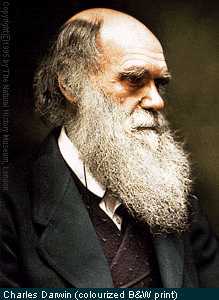
|
| Charles Darwin |
But where is Charles Darwin in all this? The survival of the fittest would suggest that successful aggressors are generally fitter, so evolution favors the victor. Perhaps swamps are somehow better for being dominated by Kudzu, pollination might be enhanced by killer bees. At first, it might seem so, but if the climate or the environment is destined to be in constantly cycling flux, diversity of species is the characteristic most highly desired. For decades, biologists have puzzled over the surprising speed of adaptation to environmental change. Mutations and minor changes in species seem to be occurring constantly, and most of them are unsuccessful changes. But when ocean currents change, or global warming occurs, or even man-made changes in the environment alter the rules, we hope somewhere a favorable modification of some species has already occurred standing ready to take advantage of the changing environment. Total eradication of species variants, even by other species which are temporarily better adapted, is undesirable. In this view, the preservation of previously successful but now struggling species is a highly worthy project. The meek, so to speak, will someday have their turn, will someday inherit the earth. For a while.
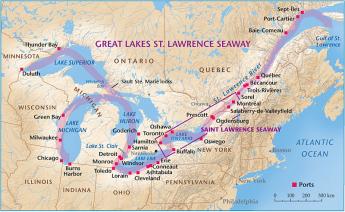
|
| St. Lawrence Seaway map |
And finally, there are variants of the human species to consider. To be completely satisfying, a commitment to preserving "native" species in the face of aggressive new invaders must apply to our own species. Surely, a devotion to preserving little plants and insects against the relentless flux of the environment does not support a doctrine of driving out Mexican and Chinese immigrants at the first sign of their appearance, like those aggressive Asian eels plaguing the St. Lawrence Seaway?. Here, the answer is yes, and no. For the most part, invasive species are aggressive mainly because they find themselves in an environment which contains no natural enemies. If that is the case, fitting the newcomers into a peaceful equilibrium is a matter of restraining their initial invasion long enough for balance to be restored through the inevitable appearance of natural enemies. So, if we apply our little nature lessons to social and economic issues related to foreign immigration, the goal becomes one of restraining an initial influx to a number which can be comfortably integrated with native tribes and clans. In the meantime, we enjoy the hybrid vigor which flourishes from exposure to new ideas and customs.
In the medium time period, that is. For the long haul, if the immigrant tribes really do have -- not merely a numerical superiority -- a genetic superiority for this environment, perhaps we natives will just have to resign ourselves to retreating into caves.
WWW.Philadelphia-Reflections.com/blog/1219.htm
Friends of Boyd
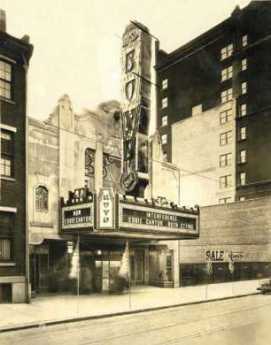
|
| Boyd Theatre |
Howard B. Haas a lawyer, and Shawn Evans an architect, are captains of a team trying to "save" the old Boyd Theatre at 1908 Chestnut Street. Since Clear Channel, the present owner has invested $13million in the property, and the preservationists agree that renovation of the movie palace to all its former glory would cost between $20million and $30million more, it's easy to understand why every other movie palace in central Philadelphia has been demolished. Furthermore, that area of town is having a resurgence of high-rise construction, so one use of the property must be balanced against others.
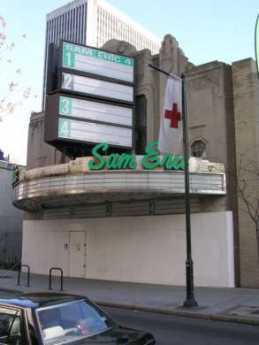
|
| Sam Eric |
The Boyd was built in 1928, just before the stock market crash, and closed in 2002. In fact, it changed its name to SamEric in its dying days, but the public remembers it as the Boyd, one of ten movie palaces in center city. The definition of a "palace" is arbitrary but is generally taken to be a theater with more than a thousand seats, normally with hyperbolic architecture to fit its hyperbolic advertising. Scholars of the matter say the earliest movie houses were constructed in Egyptian style, soon evolving into French Art Deco. Ornate, whatever it's called.
The palace concept developed in the era of silent films, with subtitles. Anyone who has experimented with home movies knows that the silent film sort of lacks something, particularly between reels and at times of breakdown in the projection. That's why brass bands played on the sidewalk outside, pipe organs played during intermissions, and all manner of vaudeville appeared on stage. Sound movies, or talkies, were immediately much more popular when they appeared in 1927, and had less need of the window dressing from other distractions which had grown into a moviehouse tradition which was slow to die.
The movie studios owned the films and soon built theaters to display them. The movie business was quite profitable from the start, so studios had the necessary finance to spread a network of very large theaters across the country quickly. The ability to concentrate hyped-up advertising with immediate display of the product in large captive theaters tended to drive the model of the "palace", which was able to sustain higher ticket prices than trickling a larger number of film copies to myriads of small "mom and pop" local theaters. In very short order, going downtown to see movies became at one time the largest reason for suburbanites to go to the center of town on public transportation, fitting in nicely with the concentration of huge department stores, also located there. Restaurants, bars, bowling alleys, and shops grew up to address the crowds. Furthermore, the economic depression of the 1930s slowed down what was to become a relentless automobile-flight to the suburbs. After the spread of free television at home in 1950, the downtown movie palaces were doomed. The legal profession helped, too. Small suburban theater operators eventually won an antitrust suit against what they described as monopoly power of studio-owned center city palaces, so a host of small sharks in the suburbs started to eat the whales downtown. Furthermore, the sound quality was easier to achieve in a smaller auditorium. To tell the truth, fire hazard was also lessened without the arc-lamps needed to project images across a long distance.
So, a new technology interacting with an old theatrical tradition quickly created the movie industry in its downtown movie palace form; more advancing technology quickly destroyed it, with a little help from economics and politics. Good luck to the friends of this historical epoch, who have a monumental task ahead to work up the public nostalgia and political strength required to overcome a huge economic obstacle of the "highest, best use of the land". In many ways, the most valuable contribution of this movie palace restoration movement is to dramatize in the public mind just how urban centers function. Department stores are gone, going in town to the movies is over. How else are you now going to get the couch potatoes to go downtown voluntarily, and often? Just imagine ten palaces simultaneously filling up with several thousand suburbanites apiece, seven nights a week. Without those additional drawbacks on ample display in Atlantic City and Las Vegas, please.
WWW.Philadelphia-Reflections.com/blog/1190.htm
Rugby in Our Midst

|
| Cricket |
American sports fans are incorrigibly provincial. The rest of the English-speaking world plays cricket, but Americans play baseball, which is vaguely related. You wouldn't know it in America, but world-wide, cricket is much more widely played and followed. American football is a vague relative of rugby; here, it's a little harder to say which of the two is more popular. The complicated and expensive padded uniforms of football push the game into varsity and professional teams, with droves of spectators. Many more rugby fans, even reasonably elderly ones, are actual players. But both games are played with a funny-looking ball with two pointed ends, and both of them score points by drop-kicking or place-kicking the ball over the horizontal bar between two upright goal posts. In the case of both cricket and rugby, the players hardly stop playing for hours, while the Americans are forever stopping for time-outs. There's a question of manliness here, but very likely the stop-go nature of both American football, and baseball, is also a response to the need for commercials on television. Catching a hardball with a big leather protective mitt, like the wearing of heavy football equipment, is a little harder to defend on the manliness feature, but the usual response is that the American games are so much faster and rougher -- protective devices are justified by common sense.
Well, that's all as may be. The more scholarly approach to game analysis goes back to the custom of Nineteenth-Century British boarding schools of having their own rules. Rugby School definitely started the game of Rugby from its origins in football, which Americans call soccer. When two teams met, the captains would agree on the rules of the day, so it was fairly easy for such games to evolve in many directions. And eventually, you can see why it was necessary to freeze the rules into some sort of international agreement. Captains of two teams who are setting today's rules will naturally attempt to play by rules that give some sort of edge to particular players on their own team. Bookies won't stand for that.
Cricket Fanatics Say Baseball is for Sissies!

|
| Alan Lawley |
Philadelphia still has six cricket clubs, and used to have more. The game of cricket was invented in 1200 AD and had its rules established in 1749 at the Marylebone Club. Baseball, on the other hand, was established in 1849 by Abner Doubleday of Cooperstown New York, with the convention of confining the runners to a diamond infield. Modern rules and established leagues of players only came along twenty years later. Actually, no one disputes that cricket is older. The question is one of manliness. Having listened for centuries to American jibes about tea and watercress sandwiches, the crickets have had enough. Their champion, Alan Lawley, recently threw down the challenge to baseball-crazy Americans at the Philadelphia Right Angle Club, where Lawley is Recording Secretary. Pardon me, blokes, but why do you tough guys consider it necessary to catch the ball with those big leather gloves? Don't you notice that cricket players catch the ball with their bare hands? Most of the excitement comes at that moment when the player is circling to catch the batted ball. He'll get it all right, but will he drop it? The essential inferiority of baseball to cricket has been documented for pages and pages by legions of British subjects, but the main point is about those gloves.
So the challenge is out. Let's see you gashouse beer drinkers take off those big protective mitts, and then try to catch the ball. And while you're at it, let's hear you pronounce Marylebone.
Tony Junker: Tunnell's Boys

|
| Henry Hudson |
When you take the ferry across the mouth of Delaware Bay from Lewes to Cape May, you are out of sight of land for half an hour. But the Army Corps of Engineers have thoroughly dredged it out. By contrast, when Henry Hudson first discovered the river while searching for a Northwest passage to the Indies, it was so full of snags and shoals that he just gave up and sailed on to what is now New York harbor. So, for centuries the river pilots were an essential part of ocean commerce to Philadelphia. As you might well imagine, the earliest pilots were members of local Indian tribes. Eventually, a proud colony of professional pilots grew up at Lewes, Delaware. Since radio communication is a comparatively recent development in this ancient trade, they had to devise ways for an incoming ship to select a pilot, and establish rules to be enforced by the Port Wardens about how to go about it.
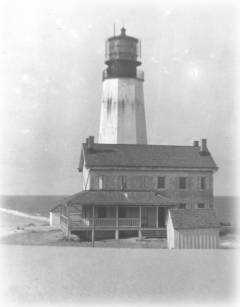
|
In the mid-Eighteenth Century, the system was to hang a black ball from the Cape Henlopen lighthouse whenever a ship was sighted. Little companies of ten or fifteen pilots would then jump into very fast schooners designed for the purpose, and race to be first out to the ladder hanging from the incoming ship's side. The rule was, the first to arrive and present his certificate got the job. Tony Junker, an actively practicing Philadelphia architect has immersed himself in tales and adventures among the pilots, and Tunnell's Boys is an exciting new novel about this dangerous, wet and uncomfortable, profession.
Community Volunteers in Medicine
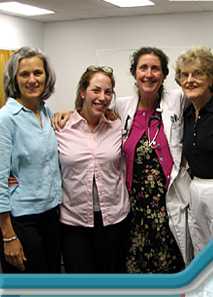
|
| Comm Volu In Medicine |
Mary Wirshup has a very different medical background from mine, but she's my kind of doctor. I couldn't help wishing, as she addressed our urban luncheon club, there could be thousands more like her, even while understanding more fully than she seems to, the reasons why doctors are driven from her behavior model. As we parted, it felt like saying a last goodbye to the Spartans marching to Thermopylae.
As 46,000 medically uninsured persons in Chester County get sickness and injuries, they know that a Federal Law prohibits a hospital accident room from refusing to see them, so ways are found to shunt patients to the CVIM free clinic, run by volunteers. This law is, in turn, a response to a government-created situation where a hospital which "accepts" patients must keep them. Any economics teacher can tell you that supply/demand issues are best addressed by price adjustment, so price controls in whatever guise lead to shortages. I must say I have little sympathy with the devious strategies which hospitals often employ to disguise their rejection of uninsured patients. At the same time, I know a lifeboat will sink if too many climbs aboard. Nevertheless, the semantic switch from lack of insurance to lack of care implies that only more insurance can surmount the barriers to care, which is absurd. For one thing, I know too many hospital administrators who are paid a million dollars a year, and one who is paid two million. And at least two health insurance executives are in the newspapers with a net worth over a billion -- yes, that's billion with a b. We have reached a point where reducing all physician income to zero would only reduce "healthcare" costs by 10%. As I look at Dr. Wirshup's modest clothing I can only surmise she plans to continue her modest living until she is 80 years old, after which her savings might see her out. Squeezing physician reimbursement is not intended to save significant money, nor intended to restore physician incomes to more equitable levels. It is intended to address the oversupply of physicians without confronting either the universities or the foreign trained lobby.
The elite tranche of medical schools do their part to relieve physician oversupply without reducing class size, through the encouragement of their students to go into research. I was well along at the National Institutes of Health before I finally decided I had not gone into medical school with that goal, and returned to teaching and patient care in a more satisfying model not too different from CVIM's obviously Pennsylvania Dutch spirit. The Amish at the far western end of Chester County reject the whole idea of insurance; their most characteristic statement is "Don't send me no bills." That attitude is rather a contrast with the shiny housing and automobiles in the Silicon Valley developments of Southern Chester County, or even with some rather bewildered Quaker farm families scattered over the rest of the county next to the horsey set. Chester County is America.
On Second Street in Society Hill, next to the park where William Penn's house stood and a few feet from Bookbinders, is the house of Dr. Thomas Bond. Bond conceived the idea of building the first hospital in America and with Franklin's publicity machine succeeded in getting it built, to care for the "sick poor". Dr. Bond started a second enduring tradition as well. When the Legislature expressed doubt that the institution was sustainable, he pledged to convince the local medical profession to serve the poor without charge. Some of the legislators who voted for the measure did so in the belief that charity care would never appear so the gesture would be without cost. The physicians did indeed come forward, in sufficient numbers to run many institutions for two hundred years. In 1965 health insurance made its national appearance and has regarded the benchmark low costs of charity care as a threat, ever since.
Valentine Tours, Right Here in River City
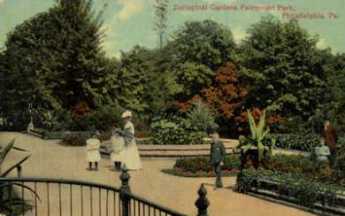
|
| Zoo Opening |
The Philadelphia Zoo claims to be the oldest zoo in America, although New York's Central Park Zoo is older. The explanation for this puzzle is that the Philadelphia Zoo was chartered by the legislature in 1859, but its opening was delayed by the Civil War until 1874. Meanwhile, the Central Park Zoo was opened in 1862. One hopes the true priorities are perfectly clear, although the Romans had zoos, and Montezuma had a spectacularly big one when Cortes arrived. Why all this wandering prologue before a discussion of a Valentine Tour? Well, since the internet is so plagued by a dispute about what is suitable for children to read, it is not clear that our Zoo's legitimate activities would escape hostile robot detection, banishment by Google, or the like if we talk about them on this website. So we will be indirect.
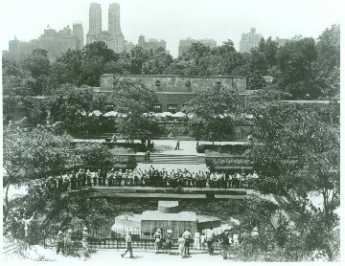
|
| Central Park NYC |
It is related that it was the women's committee of the zoo who first proposed an adult zoo camp which now goes by the name of Valentine Tours. For a modest fee of $75, it is possible to join this activity, involving discussions and demonstrations of the varieties and complexities of vertebrate reproduction. It is not only the Philadelphia public which needs education in these matters. One of the main sources of infertility among rhinos and gorillas derives from the surprising fact that they must be taught what to do. Apparently, when removed from the voyeur opportunities of their native environment, these monsters can't figure out what is expected of them.
John Bernard, a docent at the zoo for 18 years, has written a book about the varieties of romantic experiences and recently addressed the Right Angle Club on the matter. He tells of four-footers and hundred-pounders, and the like. Apparently, male elephants make their ladies wait in line for their turn, male gorillas have several girlfriends at all times, and male lions are so occupied with demands made on them that they scarcely do anything else. Bats cavort upside down, eagles lock claws and fall out of the sky, polar bears starve for months afterward. The fascination just goes on and on.
The inside details of some recent events are also revealed. Male African elephants go into a variant of heat that lasts three months and makes them dangerous to be around. That's really why the zoo recently decided to get rid of its elephant collection. Orangutans will rape a female zoo employee if given a chance. The Women's Committee of the Zoo is certainly to be thanked for alerting us. For more details, stump up the $75 and take a Valentine Tour.
Africa Comes to the Schuylkill
A journalist, John Ghazvinian, recently toured the many countries of Africa, wrote a book about it and carried his message to the Right Angle Club of Philadelphia. Philadelphia does not think of itself as particularly involved in oil matters, or African ones. But the fact is the refineries on the Schuylkill down by the airport generate two-thirds of the gasoline now used on the East Coast, and right now it mostly comes from Nigeria. There was a time when the crude oil coming to Philadelphia came from Venezuela, but politics are a little unpleasant there at present, and anyway Venezuelan oil is heavy and full of acids. The refineries which specialize in that kind of heavy oil are on the Gulf Coast. Long before the Venezuelan era, the Philadelphia refineries were constructed to refine crude oil from upstate Pennsylvania. They were once the main source of the dominance of the Pennsylvania Railroad, because oil refining from Bradford County gave the Pennsy a return freight, whereas the competitive railroads running out of New York and Baltimore had to return from the West without cargo.
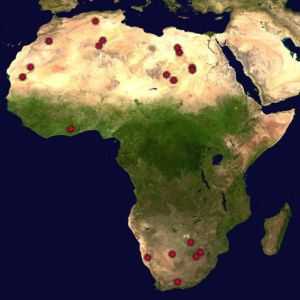
|
| African Map |
There are 54 countries on the continent of Africa, quite different from each other in character. One dominant characteristic of Africa is its lack of natural ports, and even the Mediterranean ports are cut off from the rest of the continent by the huge transcontinental stripe of Sahara desert. Major wars and famines, monstrous genocides, unspeakable cruelty, and poverty go on there without much notice by the rest of the world.
The largest country in Africa is Nigeria. Anyone with even minor dealings with Nigeria soon sees that corruption and dishonesty pass all Western imagination, and they have serious tribal warfare as well. The discovery of large deposits of oil in the region faced the international oil companies with a rather serious difficulty. For instance, Shell Oil has had over 200 employees kidnapped for ransom and is seriously contemplating abandoning its whole venture. At the moment, corruption is coped with by constructing oil wells a hundred miles out in the ocean.It's almost true that the huge tanker ships make from Philadelphia and return, without the crew talking to any natives of Africa.
We hear that genocide is in full bloom in the Sudan, and that poverty in that country similarly passes belief.

|
| Chad Poverty |
They have oil in the South of Sudan so we may hear more of it. Chad has poverty and oil, and civil war. They have a big Exxon facility, but there isn't a single gasoline station in Chad. At the moment, Angola has paused in its enormous civil war, which killed millions, and Chevron will surely encounter unrest before it is done. Gabon appears to be extremely prosperous, from oil money of course, but they are being ravaged by the Dutch Disease, of which more later.
Apparently, Equatorial New Guinea sets some sort of record for wild behavior. It has lots of oil, and a strong Chinese influence. The current
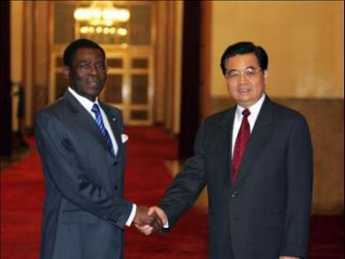
|
| Mbasogo and Jintao |
President of Equatorial New Guinea got his job by shooting his uncle. But don't feel too sorry for the uncle, who used to have an annual Christmas morning celebration, consisting of herding his enemies into a football stadium, and shooting them for the edification and entertainment of the populace. After listening to Mr. Ghazvinian, it seems small wonder that so few American tourists, or journalists, or even missionaries, manage to complete extensive African excursions. As everyone notices, if you don't have journalists, there is never any news.
Let's turn to the Dutch disease,
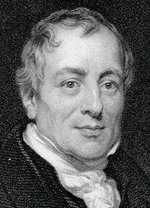
|
| David Ricardo |
of which Africa currently displays many examples likely to torment economics students for decades after Africa eventually rivals Houston. Let's start with David Ricardo, who electified the Nineteenth Century world of economics with his principle of comparative advantage. Ricardo pointed to the obvious truth that always and everywhere a nation does best for itself by identifying its best economic feature and then sticking to it. If every country wakes up and does that, every country must then trade with its neighbors for other things it isn't so suited to make. Consequently, tariffs and trade barriers are a hindrance for everyone, in time impoverishing all nations in the cycle, whatever short-run advantages of tariffs may seem enticing.

|
| North Sea Gas |
So far as I know, Ricardo was quite right, but someone had better hurry up and reconcile his underlying premise of comparative advantage with the Dutch Disease. The Dutch disease was identified and named by an anonymous writer for the London Economist about thirty years ago. Noticing that the Netherlands experienced a marked worsening of its general economy after the discovery of North Sea gas deposits, the observer for the magazine concluded that sudden accumulation of wealth in the gas industry led to a rise in the value of the Dutch currency, soon making it impossible for non-gas industries to export, unable to compete at home with now-cheaper foreign imports. Naturally, investors rushed to invest in gas, sold their holdings in other industries, and Holland was propelled in the direction of a one-industry economy, quite at the mercy of fluctuating prices of gas. This was the Dutch Disease born, and Ricardo's principle of comparative advantage exposed to quite a severe challenge from which it has not completely recovered. This is important, so how about a simpler description: When gold is discovered, people drop tools to have a gold rush. Wealth lost from dropping tools is greater than wealth gained from the gold.
Fear of the Dutch disorder seems to be the reason why the Chinese are buying our Treasury Bonds, the Japanese engaging in the astonishing "carry trade," and the Arabs buying American private equity funds. The common strand through all these schemes is this: By sending their bonanza savings abroad, they "sterilize" them from their tendency to force their currency upwards. They are exporting inflation, but also endangering their own struggling non-bonanza industries, which are the main hope for diversifying their economies and getting rid of the Dutch effect. Somewhere during this balancing act, politicians get involved and make things worse. So they call in their generals and admirals, to explore solutions we prefer they were not in a position to explore. Simpler description: When you discover oil, inflation soon follows. And all too often, revolution follows that.
The 1787 the American Constitution unknowingly cured thirteen cases of the Dutch Disease, by imposing absolute freedom of interstate commerce. After eighty years, the benefits of this national union would persuade the North to bleed and die for it. Although the Confederacy thought they were fighting for their way of life, meaning slavery, even the Southerners today recognize they are better off in a Union. Unfortunately today, the European nations are still having a hard time believing the benefits of union could possibly outweigh their allegiances to language, religion, and the wartime sacrifices of their ancestors. They are very wrong, but we are wrong to sneer at them. Except for maybe Switzerland, it is difficult to name another instance in all of history where several independent states gave up local sovereignty for the benefits of a diversified economy with local pockets of comparative advantage. Let's restate it again: the Dutch disease is a result of sudden single-industry prosperity in a country too small to control it.
By the way, what eventually happened to the Dutch? It seems likely that absorption of little Holland into the European Common Market helped dilute the corrupting effect of gas prosperity. It suggests the possibility that Dutch can be reconciled with Ricardo through the common denominator of reduced national barriers to trade and currency-- reduced sovereignty in a milder form. But it's a hard slog. Maybe we could envision annexing Alberta to soften the commotion of oil tar, but it takes a lot of imagination to see the amalgamation of China and India, any time soon. There may thus be nations too big to merge, but nevertheless, it would probably be less destabilizing to merge with all of Canada than just with Alberta if you overlook the obvious fact that it is easier to persuade a small country than a big one. Just kidding for the sake of example, of course, since Canada shows no interest in the idea.
Meanwhile, take a look backward from the highway overpass the next time you travel to the Philadelphia Airport. There's a lot more going on in those refineries than just black liquid flowing into steel pipes.
Pennsylvania Prison Society
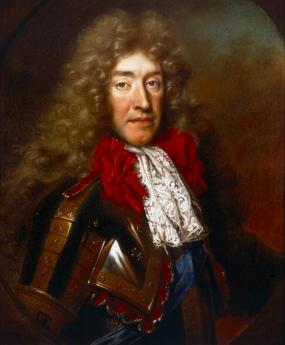
|
| Duke of York |
William Penn, who spent considerable time in British prisons, established a penal code for his new colony which largely swept away the draconian punishments established by the code of the Duke of York. Until as late as 1780, jails were mainly confinement hotels for debtors, prisoners awaiting trial, and witnesses. For actual punishment, the methods were execution and flogging. Penn's Code for Pennsylvania restricted execution to the crime of murder, and flogging to sexual offenses; everything else was punished by fines and imprisonment. Hidden in this code, of course, was the need to invent and construct prisons to service the imprisonment. It would take over a century to address this need, and Philadelphia still has not completely caught up with the need for more prison cells. Without a prison system, the Penn code was impractical, and the colonial penal code retrogressed toward floggings, pillories, and hangings after Penn's death.
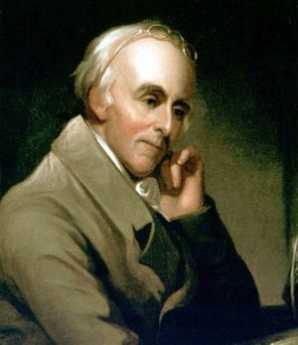
|
| Dr. Benjamin Rush |
In colonial Philadelphia, the main prison was on Walnut Street, with sixteen cells. A neighboring Quaker, Richard Wistar, started a soup kitchen in his own home, taking the soup over to prisoners. By 1773, he had established the Pennsylvania Society for Assisting Distressed Prisoners, which was unfortunately disbanded by the occupying British Army in 1777. In 1783, Dr. Benjamin Rush with the assistance of Benjamin Franklin, Bishop White, and the Vaux family, founded the Philadelphia Society for Alleviating the Miseries of Public Prisons, which after a century changed its name to the Pennsylvania Prison Society. The Prison Society believes it is the oldest continuous non-profit society in America.
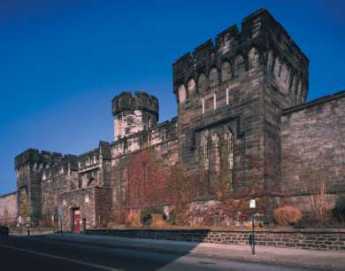
|
| Eastern State Penitentiary |
The Prison Society has had several major changes in direction. The original concept was to substitute public labor for imprisonment, a less costly arrangement than imprisonment while avoiding a return to floggings and dismemberment. However, the degrading sight of prisoners in chain gangs caused a public outcry, and the approach was abandoned. In the spirit of the French and American revolutions, loss of liberty was seen as the greatest punishment conceivable. Added to this was the Quaker concept of inspiring remorse through silent meditation, and the eventual outcome was the construction of the Eastern State Penitentiary on what was then called Cherry Hill. In 1823, it was ominous that Eastern State Penitentiary was the largest structure in America. Although the concept was widely admired and imitated, the prolix Charles Dickens took a violent dislike to the idea of never talking to anyone, and led a reversion away from penitentiaries back to simple prisons. In the days before Alzheimers and schizophrenia were well characterized, the spectacle of massive recidivism was added to the rumor that protracted solitude led to insanity.

|
| Catherine Wise |
From Catherine Wise the Communications Director of the Pennsylvania Prison Society, the Right Angle Club recently learned that the current evolution of the American penal system has led to a steady state, but a troubled one. There are 2.2 million inmates in American prisons today, more than any other nation including Russia and China. Of these, 75,000 are confined in Pennsylvania, 9,000 in Philadelphia. Recidivism is 67%, the cost is $31,000 per year per inmate, the majority of inmates have been involved with illicit drugs, a growing number are infected with HIV and Hepatitis C, mental illness runs around 20%. The cost of incarceration is growing faster than the cost of either education or healthcare for the community. Prison overcrowding is extremely serious, the programs for managing parole and integration back into society are weak and underfunded. Eighty percent of the inmates are non-white, most prisons are located in remote regions too far for easy visiting, medical care in prison would not seem at all acceptable in general society. The Prison Society has no difficulty finding projects which are urgently needed. Just for an example, take the peculiar prison statistics; it really seems improbable that only 9,000 of the 75,000 Pennsylvania prisoners are in Philadelphia. Then reflect, NIMBY, that no one wants a prison or its visitors near his home, except areas of rural poverty welcome the employment a prison brings. Reflect for a moment that "jails" are paid for by local county taxes and contain prisoners with less than two years to serve. "Prisons" are paid for with state taxes, and contain those sentenced to longer than two years. Finally, add the fact that nonvoting Philadelphia prisoners in rural prisons are counted by the census as residents of the rural area for the purpose of distributing legislative and congressional seats. The rural politicians love the system, the urban neighbors love to be rid of the prison environment, but the prisoner families can't visit the prisoner. Who cares? Who even notices?
During the first World War, Quaker interest in prison matters was greatly stimulated by the imprisonment of many Quaker conscientious objectors to the wartime draft; since that time prison conditions have again become a central interest of the religion. It's hard to prove but is confidently asserted, that violence and mistreatment of prisoners are appreciably less in Pennsylvania than the rest of the country, California for example. In any event, The Pennsylvania Prison Society is a particularly effective advocate for humane treatment because of credibility achieved over two centuries, with newspaper editors on its board, and sympathetic affiliations with the legislative judicial committees. It knows what it is talking about, as a result of over 5000 annual prison visitations, and it has served the prison administrative corps by performing volunteer work, accepting contracts for parole projects, arranging bus trips for prisoner families to remote prisons, and working for improved funding for prisons. At the moment, there are six highly imaginative bills before the Pennsylvania Legislature, devised and researched by this outside organization with credibility, and political clout. Although the Society takes an occasional contract for a project, it is itself entirely funded by outside contributions, and because of occasional adversarial situations, asks for no funds from the state. Even the contract funds have been questioned, and are only accepted when the working relationships fostered are more useful for the prisoner clients than any co-option which might result.
One final word about medical care in prison. It's not as good as medical care for non-prisoners, and unfortunately it probably never can be. The remote rural location of prisons makes it difficult to obtain physicians and nurses, regardless of wage levels. It's dangerous to be around prisoners, as any guard will tell you, and it's more dangerous to be in control of narcotics amidst a population of addicted convicts. Malingering is nearly universal, both to obtain desired drugs and to spend "easy time" in the infirmary. Many prison escapes are engineered around the necessarily weakened security of the medical system. The prison budgeting system has all the rigidity and weaknesses of any governmental medical system, and in this case, it's run far out of sight of the public. Even the bureaucrats in charge are victimized by other bureaucrats. The average duration of incarceration in Pennsylvania is longer than in most other states; the prisons have to keep mental patients because the mental hospitals have all been closed. Fifty years ago, when there was no place to put a non-criminal with tuberculosis, he was put in jail. The parole system is underfunded, there is not nearly enough community support to absorb ex-con. Behind all this is a shortage of prison facilities. The legislature has got itself into a position that if it moved more prisoners into the outside, more prisoners would just fill the vacancies, costs would go up, and things wouldn't look much better. Only after the backlogs have been absorbed, would there be much visible effect.
OUR NICE HOUSING BOOM COLLAPSES
Three Basic concepts at work:
- Steep yield curves (the normal situation) are good for banks; inverted curves (a rarity) are not. The 2006 inversion was caused by the bond market accepting abnormally low long-term interest rates, so the "spread" between risky loans and safe ones displayed a diminished "risk premium".
- The Federal Reserve then lowered short-term rates by printing more currency.
This caused an inverted yield curve to return to its normal shape, but the 2006 problem was caused by too much(Chinese) money and this action added to it. The banks were rescued, but the currency was inflated. - This innovative response will probably become a standard readjustment.
But it only keeps the ship from tipping over after a sudden wave; it doesn't address the approaching storm.
 Risk premiums soared in August 2007. What seemed safe, abruptly was risky, and only available at higher prices. 
|
What happened in August?....The "risk premium" --and, consequently, mortgage interest rates-- suddenly went back to normal. About $90 billion of foreclosures seemed probable. We had built far too many houses for people who couldn't afford them. Surplus houses remain for ten years, depressing all real estate prices, making everybody feel poor. Recession, anyone?
What did the Federal Reserve do? To protect the banks, Bernanke dropped short term interest rates. (This steepens the yield curve.) As the panic spread, he dropped rates some more (This floods the country with money). Inflating the currency cheapens the dollar, which robs foreign investors. Foreigners sold stock to escape, prices fell. Seeing prices fall, everybody else sold a stock. 1929, anyone?
So what? They're only foreigners. If Bernanke raises interest rates, we get a recession. If he keeps them low for too long a time, we may get hyperinflation. So, he probably hopes to drop them for a few months, then raise them again. Jimmy Carter got "stagflation" trying this sort of thing. Green eyeshades, anyone?
Remember how naughty "redlining" was? Well, now we bash the banks for "stupid mortgages". Banks issued cheap mortgages for inflated real estate -- and immediately sold the "subprime loans" to investment bankers as "collateralized bonds". We are still uncertain who holds these things, but at least $40 billion were in the hands of Wall Street when the music stopped. Wall Street had to sell perfectly good (?) stock to pay their debts. Blue chips, anyone?
Why was the risk premium so low? The Far and the Middle East had something to do with it. But mainly, securitization led to undue emphasis on statistics. In a housing boom, foreclosure rates seem to go down but are really only being diluted by new loans. The fall of BNP Paribas was a sudden wake-up. Then, the computers of the "quants" exposed a flaw in their programs when they detected heavy selling of perfectly good stock and announced the End of the World..
Thank heaven it happened before things got serious.
WWW.Philadelphia-Reflections.com/blog/1331.htm
Sacred Places at Risk
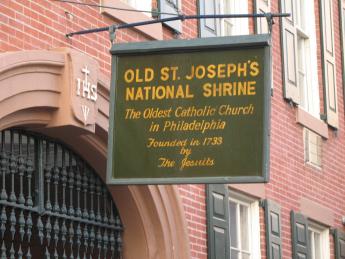
|
| Old St. Joe's |
When William Penn invited all religions to enjoy the freedom of Pennsylvania, he created a home for the first churches in America of many existing religions, and furthermore the founding mother churches for many new religions. Regardless of the local congregation, there is obviously a strong wish to preserve the oldest churches of the Presbyterian, Methodist, United Brethren, African Methodist Episcopal, Baptist, Mennonite, and many other denominations. While the founding church of Roman Catholicism was obviously not in Philadelphia, St. Josephs at 3rd and Willing was for many decades the only place in the American colonies where the Catholic Mass could be openly performed. The towering genius of William Penn lay in the combination of an almost saintly wish to spread religious toleration, combined with what must have been a sure recognition that the motive of Charles II in giving him the land, was to get rid of all those dissenters from England.
Philadelphia now has a thousand church structures within the city limits, and more than a thousand in the suburbs. However, many church buildings find themselves stranded by the migration of local ethnic groups to other locations, and a decision must be made whether to demolish a relic or sell it to a new population who have moved into the old neighborhood with a new religion. There is still greater discomfort with selling an old church to a commercial enterprise, but even that happens. The resulting bewilderment and dissension among the surviving parishioners is easy to imagine as they face these choices, or fail to face them, and it is readily imagined that the establishment in 1989 of Partners for Sacred Places filled a very important need.
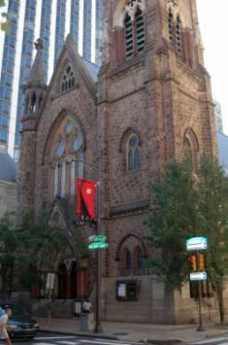
|
| First Presbyterian Church |
The Executive Director, Robert Jaeger, recently described to the Right Angle Club how the Partners operate. First of all, the Constitutional separation of church and state makes it difficult to seek funding or even advice from the Federal government. Pennsylvania has been less hesitant than most states in this regard, but even here the issue of fund-raising is a central issue. One only has to look at the Aztec and Mayan religious sites in Mexico to grasp that there are circumstances when the parishioners of a religion may have completely died out, but their monuments justify state assistance. Private, nondenominational philanthropy seems the easiest route for a society to take, in avoiding the obvious political and legal entanglements of seeming to assist one denomination more than others.
And then there are architectural issues;, can the building be saved at a reasonable cost, is it truly a unique or outstanding piece of art, can a reconstruction go ahead in an incremental way, are the necessary stone or other materials any longer obtainable, do the workman skills exist? In addition to these issues which are commonly presented to a congregation, there are issues they probably have never considered. As congregants move from center-city to the suburbs, they become commuters to church, largely out of touch with the local community and its activities. A survey conducted by the Partners suggests that 81% of the activity which takes place in church buildings on weekdays is conducted by and for non-members of the church; if the two groups lose touch with each other, opportunities are missed, and eventually there may be unnecessary friction. On the other hand, those non-religious activities probably escape the legal prohibitions against government assistance, and may suit themselves as vehicles for indirect government support. The approach has so much promise that Partners for Sacred Places has devised a computer program on their website which provides a way for congregations to assess their assets, and their problems. In fact, the organization conducts extensive training programs for church preservation, and has been forced by the size of the demand to exclude churches that are clearly failing beyond reasonable hope of recovery by their church membership.
The Partnership was originally founded by consolidation of the New York and Philadelphia organizations, to make a stronger national effort. But now things are going the other way. New chapters are springing up in Texas and California. Partners for Sacred Places is obviously proving to be a good idea, effectively managed.
WWW.Philadelphia-Reflections.com/blog/1269.htm
Quaker Gray Turns Quaker Green
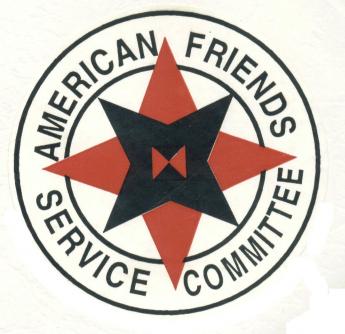
|
| American Friends Service Committee Logo |
Miriam Fisher Schaefer, at one time the Chief Financial Officer of the American Friends Service Committee, had to cope with the economics of renovating the business headquarters complex for various central Quaker organizations. They're housed in a red-brick building complex, naturally, located on North 15th Street right next to the Municipal Services Building of the Philadelphia City Hall complex. The original building within the complex is the Race Street Meetinghouse, funds for which were originally raised by Lucretia Mott. The Quakers needed to expand and renovate their offices, a nine million dollar project. Miriam, a CPA, calculated that the job could be made completely environment-friendly for an extra $3 million. The extra 25% construction cost explains why very few buildings are as energy-efficient as they easily could be. However, in the long run, a "green" building eventually proves to be considerably cheaper. Not only would a green Quaker headquarters be a highly visible "witness" to environmental improvement, but it would also pay for itself in reduced expenses after about eight years. That is, if friends of the environment would provide $3 million in after-tax contributions, they would provide a highly visible example to the world, and reduce the running expenses of the Quaker center by a quarter of a million a year, indefinitely. Effectively, this is a charitable donation with a permanent tax-free investment return of 12%, quite nicely within the Quaker tradition of doing well while doing good.
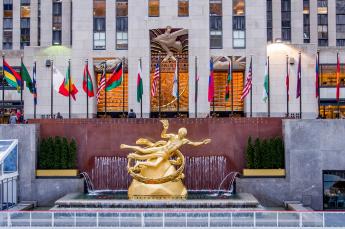
|
| Rockefeller Center |
Energy efficiency isn't one big thing, it is a lot of little things. If you dig a well deep enough, its water will have a temperature of 55 degrees, and only require heating up another 15 degrees to be comfortable in winter, or cooling down thirty degrees to be comfortable in the summer; that's described as a heat pump. Then, if you plant sedum, a hardy desert succulent plant, on the roof it will insulate the building, slow down rainwater runoff, and probably never have to be replaced. Rockefeller Center, you might be interested to learn, has a "green roof" of this sort, which has so far lasted seventy years without replacement. The Race Street Meetinghouse was built in 1854 and has so far had many roof replacements, each of which created a minor financial crisis when the need suddenly arose.
The ecology preservation movement is full of other great ideas for city buildings because buildings --through their heating, ventilating and air conditioning -- contribute more carbon pollution to the atmosphere than cars do. For another example, fifty percent of the contents of landfills originate in dumpsters taking construction trash away from building sites. What mainly stands in the way of more recycling of such trash is the extra expense of sorting out the ingredients. Catching rainwater runoff allows its reuse in toilets, eliminating the need to chlorinate it, meter it, and transport it from the rivers. And so forth; you can expect to hear about this sort of thing with great regularity now that the Quakers have got stirred up. You could save a lot of air conditioning cost by painting your roof white. At first, that would look funny. But do you suppose oddness would bother the Society of Friends for one instant? No, and you can expect them to make it popular, in time. People at first generally hate to look funny, but with the passage of time they grow to like looking intelligent.
A lot of people want to save the planet. So do the Quakers, but they have come to the view that the public is more easily persuaded to save money.
The University Museum: Frozen in Concrete
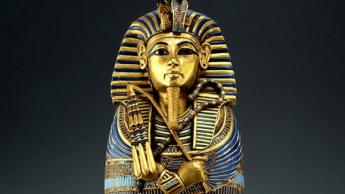
|
| King Tut |
Recently, a charming archeology scholar from the University of Pennsylvania, Leslie Ann Warden, entertained the Right Angle Club with the interesting history of King Tut. Interest in this subject is currently heightened by a traveling exhibit of the tomb relics currently on elegant display at the Franklin Institute. However, Philadelphia also has a permanent exhibition of Egyptian artefacts lodged in the University Museum. Since this museum is the second largest archaeology museum in the world, after the British Museum, that makes it the largest in America. An interesting sidelight is that Ms. Warden spoke in the grill room of the Racquet Club, which was the first effort by William Mercer to use "Mercer" tiles in a building. Mercer at that time was the curator of the University Museum. We learned from Ms. Warden that King Tutankhamen was unknown before his tomb was discovered, all records of this part of the Egyptian dynasty having been lost or deliberately obliterated by successors. Therefore, the discovery of these magnificent art objects started a massive expansion of scholarship about the entire Third Millenium.
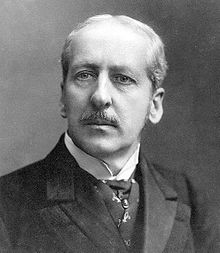
|
| William Pepper |
The establishment of the University Museum around 1890 was apparently mostly due to the enthusiasm of William Pepper, then Provost of the University of Pennsylvania. What seems to have got Pepper going was an expedition to Iraq, the place where civilization began, in Mesopotamia. The relics brought back from this celebrated effort needed a home, and Pepper decided it had to be here. One famous philanthropist after another, often in the role of Chairman of the Board of Trustees, carried on the tradition after Pepper's premature death. Some of them have their names on buildings, some declined. To a notable degree, the feeling of special possession was exemplified by Alexander Stirling Calder, who turned the statues in the garden to face inward rather than out toward the street. Asked whether a mistake had been made, he is said to have replied that due to the Museum's withdrawn character, it was more appropriate for the world to face the Museum. No more icily accurate comment has ever been made about the University's relation to its city neighbors.
The real knock about the Museum is that too much has been crowded into too little real estate, and the fault lies with the automobile. After the University outgrew its space at 9th and Market around 1870, moving then to West Philadelphia, the architects and the donors originally envisioned a grand boulevard of culture stretching from the South Street bridge many blocks westward. The Museum, Franklin Field, Irvine Auditorium, The University Hospital were to be the start of an imposing array of culture. Unfortunately, that was a horse-drawn conception, soon to be overwhelmed by the worst traffic jam in the city. The Schuylkill Expressway was the final blow, setting huge auto-oriented structures in place where their easy removal became difficult to imagine. The 1929 stock crash, followed by confiscatory income and estate tax rates, merely emphasized the plain fact that restoring the grand vision was beyond the ordinary aspirations of even massive private wealth. Transforming the imposing plazas of the University Museum into parking garages was probably a result of excessive despair, but if you have ever tried to find a place to park in that region you can somewhat sympathize with the small-mindedness which prompted it. Bringing back this region is going to require immense vision and resources, neither of which is exactly thrusting itself forward at present. So, unfortunately, one of the central cultural jewels of the City is buried in the midst of an impenetrable thicket of concrete and speeding automobiles, too big to move, too small to burst its bonds.
It's well worth a lot of anybody's time, and many visits. If you can find a way to get there.
Laran Bronze
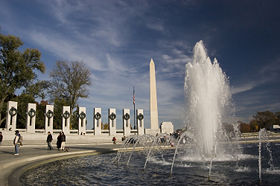
|
| World War II Memorial |
Bronze is the term for alloys of copper, most often mixed with tin, aluminum or whatever in varying proportions. Although the Bronze Age was one of the earliest stages of civilization, most of us would still have a hard time even stating the proper mixture of metals we might need to manufacture some bronze object for some particular purpose. No doubt Alexander the Great and his friends just stumbled on a mixture suitable for swords, helmets, and shields, but nowadays we expect a little more precision than that. So, go visit the engineers and artisans who occupy a whole block of downtown Chester and discover where the engineers take over from the sculptors. For example, the bronzes of the World War II Memorial in Washington were fabricated here, eventually bringing the final bill for the Memorial to $197 million. Whatever Laran may be, it isn't cheap.
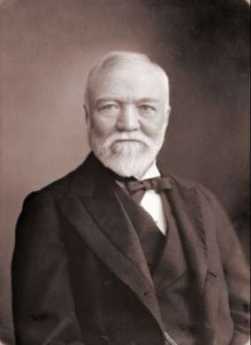
|
| Andrew Carnegie |
Because of the size and weight of monumental bronzes, there is a tendency for bronze fabricators to be chosen in the general neighborhood of the permanent site of the statue. Even so, most large pieces are cast in smaller pieces and welded together at the site. Because that leads to more external struts that have to be trimmed and smoothed out, and more welding, there is a constant struggle to improve the technology to eliminate chop-ups. However, the bigger the piece, the harder it is to support with internal steel struts, so there is a constant process of re-engineering which is considerably under-appreciated. Since Larry Welker the proprietor of this operation went to Carnegie-Mellon, it brings up an analogous situation in steel fabrication. Andy Carnegie is mostly remembered for giving away libraries and mistreating his employees, but in fact, his achievement was an engineering one. His steel mills were four times as productive and efficient as his nearest competitor (Krupp of Germany). That not only made him the richest man in the world, it also made it possible for America to defeat Germany in World War I, and eventually become the dominant superpower.
Since sculptors are in a position to designate the bronze fabricator of their work, it would be wise for the fabricator to be nice to sculptors. However, computers have stuck their nose in this business, as they have in most businesses. A sculptor ordinarily makes a small model whose image is scanned into a computer and then blown up to final size. From this, a positive mold is made, from that a negative mold, and from that, the final positive bronze shell is cast. But once you pass that image through a computer you open up the possibility of synthetic images made through the mechanisms that make animated movies; and maybe eliminate the need for the sculptor entirely. That prospect naturally displeases sculptors, as does the potential for counterfeiting and exporting jobs.
Just about everything about bronze sculpture revolves around its massive weight. That's why bronze statues are typically hollow but carried too far, the statue can't support its own weight and must have internal steel struts. The internal struts are mainly stainless steel, often encased in the plastic sheathing. The molds which make these eggshells are generally made of ceramic, which is melted sand. The process starts with wax coatings, often a quarter-inch thick dipped in fine sand, then a layer of coarse sand finally baked into ceramic. That's the negative mold; the positive mold from which it is made starts with wax, covered by latex, covered by plaster of Paris. Since a lot of steps don't come out perfectly, they have to be repeated. All in all, it becomes convincing that spending $197 million for a war memorial is entirely legitimate, because we haven't even described the costs for the artist at one end of the process, and the appalling transportation issues at the final step.
Although the WWII Memorial isn't even in Philadelphia, it's surely worth a trip to Washington to see what Philadelphia can do. While you are there, look for the "Easter Eggs". That's the term for humorous images hidden by the artist within the serious larger object. This too is a tradition going back to ancient times; in the case of the War Memorial, the artist hid images of at least one soldier "goofing off" in each freeze. Perhaps even that could be done by computer, but it's harder.
WWW.Philadelphia-Reflections.com/blog/1291.htm
Neopolitan Right Angle
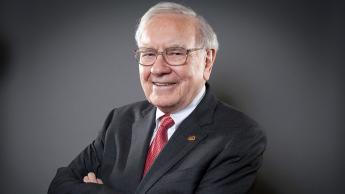
|
| Warren Buffett |
The Right Angle Club of Philadelphia recently heard from a former member, Merrill Roth, who has moved to Naples, Florida. Such retirement places are populated by people from all over the country, all anxious to show the merits of where ever they came from. So, Merrill decided to transplant one of Philadelphia's jewels to the West Coast of Florida; he started a Right Angle Club of Naples, meeting monthly in the Vanderbilt Club. By great good luck, he discovered that one day a week was Ladies Day at the golf course, an ideal circumstance for founding a men's club. Before he knew it, he had a hundred members, filling up the dining room to capacity.
So, being Merrill, he started a second one, which has now grown to thirty members. One of the central themes of these clubs is that Naples has a great many cultural events and institutions, but newcomers have trouble locating them. So his clubs fill a local need.
Since he started the clubs, he had to arrange for the speakers, and shouldering this burden for the rest of his life now seems a little daunting. So, it was useful to remind him that the Philadelphia Right Anglers of the Mother Church assign that task for only a year since most everybody can find forty friends who can speak, but nobody wants to do that forever. Other clubs encounter the same issue, and one solution has been to hire an executive director of the club and have him get the speakers. Since nobody knows an infinite number of entertaining speakers, that soon gets to be too much; and so the executive director hires a program director. Pretty soon that gets expensive, and the club starts going to agencies. The whole thing eventually loses its character as a voluntary fraternal group, gets unaffordable, and the programs wander away from the interests of the members. The only thing worse is to own your own clubhouse. The seeds of the club's destruction are sown by failing to appreciate these realities of club dynamics. Warren Buffett tells investment advisors to eat their own cooking. The club variation of that sage advice, is, get your own speakers.
Please Touch
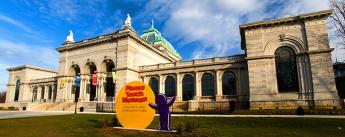
|
| Please Touch Museum |
There had been rumors for some time that the Please Touch Museum was planning to move from 21st Street to larger quarters, but recently its Executive Director Laura Foster appeared at a luncheon at the Franklin Inn Club to announce definite plans. The Museum moved into Memorial Hall in West Fairmount Park in the fall of 2008.
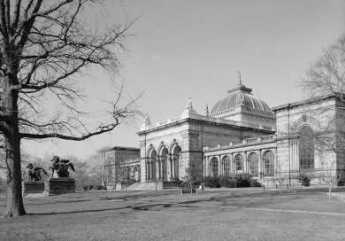
|
| Memorial Hall Fairmount Park |
There are over 400 children's museums in the world, and the first one was started in Brooklyn in 1899. Just why Philadelphia waited until the Bicentennial Celebration in 1976 to start one, is not clear. It's particularly unclear when you hear of its explosive success. Growing rapidly during an era when museums of all sorts are seeing declining attendance, the Please Touch Museum will be making its fourth move in thirty years, each time to larger quarters because they needed more room. Sooner or later, expansionism will get its comeuppance of course, and Memorial Hall is one awfully large building to fill. And to heat, and to paint, and to air condition. The price is right, however. The City Administration, which approached the museum with a proposal, has offered an 80-year lease for a dollar. When you hear that they have occasionally had 1500 visitors in a single day, however, and annual attendances approaching 200,000, almost anything seems possible.
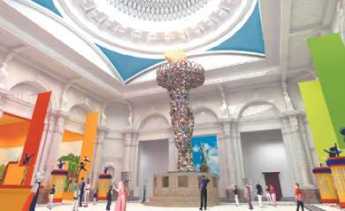
|
| Liberty Torch |
There are certain limits. Nothing frightens a 4-year-old like a herd of 10-year-old boys racketing about, so there are segregations necessary. In other situations, these little kids not only can't touch, but they also can't see and they want to see badly. And the sociology is interesting. The kids may well clamor to come when they hear other kids talking, but in general, it is the parents who get the idea that a museum trip would be fun. And the parents seem motivated by theories of upward mobility, of giving their child a "leg up" on the competition. The museum is certainly filling a need, but you have to wonder where our society is headed if a picnic in the park is mainly a good idea if it gives junior a leg up.
Meanwhile, keep tuned. To fill up that monstrous Memorial Hall will take publicity, and these gals sound as though they mean to have a lot of it.
Tree Huggers: Delaware Valley College
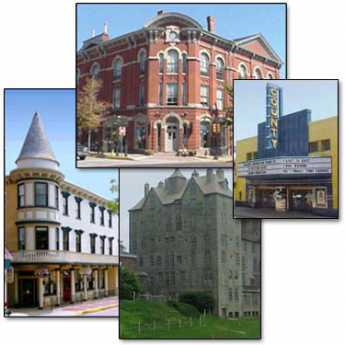
|
| Doylestown, PA |
At the time when Philadelphia and New York were both occupied by the British during the Revolutionary War, a backwoods highway connected the thirteen colonies. Doylestown is 35 miles due north of Philadelphia City Hall, at the point of intersection of this variant of the Ho Chi Minh Trail with the path which Philadelphia Tories took in their flight to Kingston, Ontario. No doubt there were some interesting conversations in Mr. Doyle's tavern at the crossroads.
Doylestown is also on the invisible border between the hegemonies of Philadelphia and New York, where descendants of German and Quaker farmers make a cautious contact with the distinctly non-Quaker artists and writers fleeing south from New York. James Michener and Pearl Buck once represented Philadelphia in the cultural stew with New Yorker ex-patriots, Somehow in this interface, a place is found for the Delaware Valley College, which started life in 1896 with Jewish founders of the National Farm School. The original board of trustees included such names as Gimbel, Lit, Snellenburg, and Erlanger, but the three-year curriculum was entirely agricultural. The founder himself was Joseph Krauskopf, who got the idea after an inspiring interview with Count Leo Tolstoy.
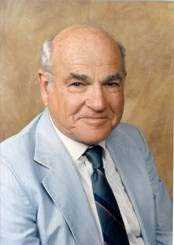
|
| Baruch Blumberg |
From a single building which served as classroom and dormitory, the college has grown into a four-year institution in numerous buildings scattered over a 570-acre plot with a second 120-acre farm in Montgomery County. The school is determinedly non-sectarian, and for forty years has been coeducational. It has had several changes of name, from the National Farm School, eventually to its present name. The curriculum has expanded as well, with masters degree programs in business and education. Baruch Blumberg, the Nobel Prize winner in Medicine, maintains an office there, and it is clear the college means to shift its emphasis toward the scientific basis of agriculture and the environment. It's also pretty clear that rising agricultural prices will soon re-establish agriculture as a dominant feature of our economy, although agriculture in the modern sense is quite a distance from farming in the old sense, and requires a different sort of educational preparation.
The Right Angle Club of Philadelphia recently heard from Joshua Feldstein the chairman of the board of trustees, and the brand-new president, just moving in from Columbia University. Sixty-eight years of driving ambition is personified in one, and the bright shining future in the other. We wish them well.
By the way, the tree hugger nickname comes from a campus tradition of this college, very much an active ceremony, of hugging the 400-year-old oak standing beside the president's house on the campus. The College, of course, is 250 years younger than the tree.
WWW.Philadelphia-Reflections.com/blog/1295.htm
Link to Right Angle 2008
To skip back to the 2008 yearbook, click the indicated place below:
» Click here for RIGHT ANGLE CLUB 2008 «
20 Blogs
Whither, WHYY
 Current American law now makes it illegal to broadcast the currently free (analog) version of television after Feb 1, 2009. Couch potatoes, man the barricades.
Current American law now makes it illegal to broadcast the currently free (analog) version of television after Feb 1, 2009. Couch potatoes, man the barricades.
Recording for the Blind and Dyslexic
 Out in King of Prussia, almost 300 volunteers make tape recordings of textbooks for people who can't read.
Out in King of Prussia, almost 300 volunteers make tape recordings of textbooks for people who can't read.
Native Habitat
 Increased foreign trade, especially to Asia, has brought us some new plant types. Lacking natural enemies, they are taking over.
Increased foreign trade, especially to Asia, has brought us some new plant types. Lacking natural enemies, they are taking over.
Friends of Boyd
 The last movie palace in Philadelphia is either ready for restoration, or the wrecking ball.
The last movie palace in Philadelphia is either ready for restoration, or the wrecking ball.
Rugby in Our Midst
 Englishmen play cricket and rugby. Americans play baseball and football. The rest of the world plays soccer and calls it football.
Englishmen play cricket and rugby. Americans play baseball and football. The rest of the world plays soccer and calls it football.
Cricket Fanatics Say Baseball is for Sissies!
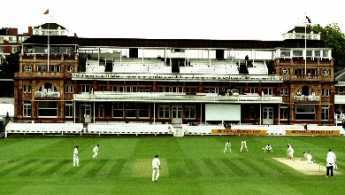 Cricket players may drink tea and eat watercress sandwiches, but they catch the batted ball with their bare hands, don't allow designated hitters, and keep playing one game for as long as five days. So, who's a sissy?
Cricket players may drink tea and eat watercress sandwiches, but they catch the batted ball with their bare hands, don't allow designated hitters, and keep playing one game for as long as five days. So, who's a sissy?
Tony Junker: Tunnell's Boys
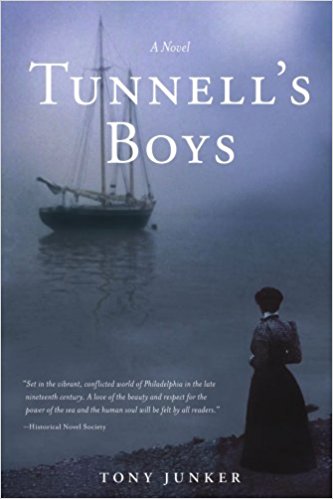 Pilots once had to race from the mouth of Delaware Bay to meet incoming ships. First one there got the job.
Pilots once had to race from the mouth of Delaware Bay to meet incoming ships. First one there got the job.
Community Volunteers in Medicine
 A little group of medical volunteers in Pennsylvania's Chester County may not understand the underlying issues very well, but they just pitch in and do what they can about the medically underserved.
A little group of medical volunteers in Pennsylvania's Chester County may not understand the underlying issues very well, but they just pitch in and do what they can about the medically underserved.
Valentine Tours, Right Here in River City
 The First Zoo in America specializes in breeding animals that are hard to breed in captivity. The Women's Committee decided to bring this delicate topic out into the light.
The First Zoo in America specializes in breeding animals that are hard to breed in captivity. The Women's Committee decided to bring this delicate topic out into the light.
Africa Comes to the Schuylkill
 African oil, refined in Philadelphia, supplies 2/3 of the gasoline on the East Coast.
African oil, refined in Philadelphia, supplies 2/3 of the gasoline on the East Coast.
Pennsylvania Prison Society
 When the British monarchy put William Penn in jail, they set in motion a social movement which has changed prison management more than it changed Penn.
When the British monarchy put William Penn in jail, they set in motion a social movement which has changed prison management more than it changed Penn.
OUR NICE HOUSING BOOM COLLAPSES
 Politicians will assign blame for the housing boom-and-bust, but they should look at themselves. Which is worse, "red-lining" or "stupid loans"?
Politicians will assign blame for the housing boom-and-bust, but they should look at themselves. Which is worse, "red-lining" or "stupid loans"?
Sacred Places at Risk
 Church structures don't migrate, but church members do. A volunteer organization in Philadelphia has formed, to help endangered congregations decide how to review their options and act on the best choice.
Church structures don't migrate, but church members do. A volunteer organization in Philadelphia has formed, to help endangered congregations decide how to review their options and act on the best choice.
Quaker Gray Turns Quaker Green
 Quakers mean to turn their headquarters near Philadelphia City Hall into a glowing example of how to save money while they save their environment.
Quakers mean to turn their headquarters near Philadelphia City Hall into a glowing example of how to save money while they save their environment.
The University Museum: Frozen in Concrete
 Archaeology has long been at the center of Philadelphia culture. The University Museum of Archaeology, the largest of its kind in America. is a victim of success, stranded in a congested and overbuilt corner of town.
Archaeology has long been at the center of Philadelphia culture. The University Museum of Archaeology, the largest of its kind in America. is a victim of success, stranded in a congested and overbuilt corner of town.
Laran Bronze
 Occupying an entire block of industrial Chester, a little industry of mechanized artist-engineers make most of the big bronze statues in Eastern America.
Occupying an entire block of industrial Chester, a little industry of mechanized artist-engineers make most of the big bronze statues in Eastern America.
Neopolitan Right Angle
 A transplanted Philadelphian plants a metastasis in Florida.
A transplanted Philadelphian plants a metastasis in Florida.
Please Touch
 The Please Touch Museum, a roaring success story, is planning to move too much larger quarters in the Fall of 2008.
The Please Touch Museum, a roaring success story, is planning to move too much larger quarters in the Fall of 2008.
Tree Huggers: Delaware Valley College
 Delaware Valley College is a curious mixture of farm school with scientific aspirations and a Jewish history, located in Doylestown, where New York City and Philadelphia meet,
Delaware Valley College is a curious mixture of farm school with scientific aspirations and a Jewish history, located in Doylestown, where New York City and Philadelphia meet,